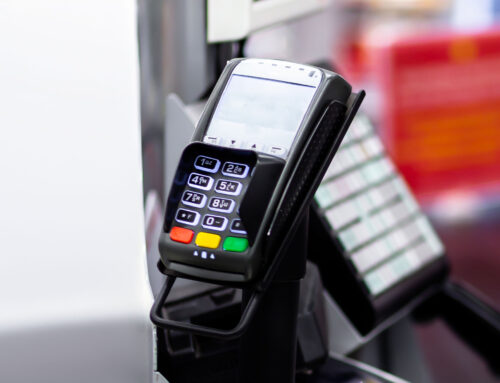MasterCard, Visa, American Express and Discover have all announced their plans to move forward with EMV-based payments and acceptance. In fact, most Americans who have received a new card in 2014 should have both EMV and magnetic swipe capabilities. The conversion is currently happening but will take a few years for many merchants to fully integrate this technology.
EMV (named after its original developers Europay, MasterCard, Visa) chip technology is the next step in the right direction to help combat credit card fraud and protect sensitive data. It is becoming the global standard for credit and debit card acceptance. EMV chip cards have microprocessors on the face of the card that interact with the acceptance devices. Instead of swiping your credit card, we will start inserting the card halfway into the terminal for it to be read. EMV cards can also support contactless card reading, known as near field communication (NFC) but most institutions are just issuing contact cards for now. Every time you use EMV chips, data is transferred between the card chip and the issuing financial institution to authenticate the card and create unique transaction data through the use of dynamic authentication.
There will be a signature or pin required for the transaction depending on what verification method is tied to your EMV card, instead of whether it’s a credit or debit card. When you enter a pin it connects the terminal to the payment processor for real-time transaction verification and approval. If the payment processor is not equipped with chip-and-PIN credit transactions, it will step down to signature verification. Signature will be the most popular option with the EMV cards to start, taking this integration slowly. Once the majority of consumers in the United States has EMV cards, we should start seeing more usage of chip-and-PIN.
Merchants are being told that there is an October 2015 deadline to start accepting EMV cards, however, it is believed that it will take a few years to get everyone to start accepting it. Automated Fuel Dispensers have been given until October 2017 to start accepting EMV cards at the pumps but still have the October 2015 deadline for inside the store transactions. This is because becoming EMV capable is going to be a big cost for some merchants. The benefit to merchants on this date is that if they are EMV capable – they are protected from financial liability for card-present counterfeit fraud losses.
If merchants are not capable of accepting EMV cards by October 2015, the liability will shift to the merchant or whichever party is least EMV/PCI compliant.
EMV helps fight fraud in a few ways. The EMV card, as mentioned earlier, has a microchip embedded in the card that stores information securely which cannot be accessed by unauthorized parties. This helps prevent card skimming and cloning which is one of the most common ways magnetic stripe cards are stolen and used for fraudulent transactions. When the EMV chip is communication with the issuing financial institution it creates unique data for that specific transaction. If that data is somehow stolen, it cannot be used for a different transaction, the new transaction would be denied. There are also developments being made with card-not-present (CNP) transactions and EMV which should help cut down on fraudulent internet transactions such as one-time passwords, on-card displays, or features accessible via personal card readers.
Just because we started switching to EMV does not mean that we are completely protected from fraud. It is a step in the right direction but as technology changes, so do the hackers who steal this information. It is still highly suggested to become EMV compliant as soon as possible. This will minimize your risk and make it harder for hackers to obtain your information.
If you have any additional questions about EMV technology or want to know how you can become EMV ready, please give us a call!





